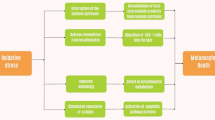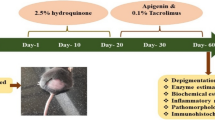Abstract
Vitiligo is a chronic, autoimmune destruction of melanocytes, resulting in progressively expanding depigmented skin patches. Severity of the disorder, which affects approximately 1% of humans, may be mitigated using topical corticosteroids combined with phototherapy; along with other clinical strategies; however, no definitive cures are currently available. Here, the capacity of apigenin, a plant-derived aglycone, to inhibit oxidative stress–mediated melanocyte depletion in vitro using a PIG3V vitiligo perilesional melanocyte cell model is evaluated. PIG3V cells, treated with selected doses of apigenin, were challenged with H2O2, then assessed for viability and the oxidative stress–related parameters: superoxide dismutase (SOD), catalase (CAT), glutathione peroxidase (GSH-Px), and malondialdehyde (MDA) by enzyme-linked immunoabsorbent assay (ELISA). Additionally, expression of nuclear factor erythroid 2p45 (NF-E2)–related factor 2 (Nrf2) and downstream targets was detected using Western blotting. Outcomes demonstrated that compared with negative control cultures, apigenin-treated cells exhibited enhanced viability. Likewise, apigenin enhanced expression of the cellular anti-oxidants SOD, CAT, and GSH-Px, but inhibited production of MDA, an oxidative stress biomarker. Interestingly, the expression and nuclear localization of the Nrf2 transcription factor, an important regulator oxidative stress and its downstream target genes, was significantly increased by apigenin treatment. Apigenin influence on Nrf2 was further validated by experiments demonstrating that Nrf2 knockdown cells failed to exhibit significant apigenin-mediated effects on cell viability and oxidative stress. Apigenin’s non-toxicity and ability to affect multiple oxidative stress–related parameters through its effects on Nrf2 signaling in melanocytes suggests that it may prove to be a valuable therapeutic tool in long-term management of vitiligo.







Similar content being viewed by others
References
Agrawal D, Shajil E, Marfatia Y, Begum R (2004) Study on the antioxidant status of vitiligo patients of different age groups in Baroda. Pigment Cell Res 17:289–294
Andueza A, García-Garzón A, de Galarreta MR, Ansorena E, Iraburu MJ, López-Zabalza MJ, Martínez-Irujo JJ (2015) Oxidation pathways underlying the pro-oxidant effects of apigenin. Free Radic Biol Med 87:169–180
Boissy RE, Manga P (2004) On the etiology of contact/occupational vitiligo. Pigment Cell Res 17:208–214
Chang Y, Li S, Guo W, Yang Y, Zhang W, Zhang Q, He Y, Yi X, Cui T, An Y, Song P, Jian Z, Liu L, Li K, Wang G, Gao T, Wang L, Li C (2017) Simvastatin protects human melanocytes from H2O2-induced oxidative stress by activating Nrf2. J Investig Dermatol 137:1286–1296
Chernov VM, Chernova OA, Mouzykantov AA, Lopukhov LV, Trushin MV (2018) Mycoplasmas and novel HO-1 inducers: recent advances. Curr Pharm Des 24:2236–2240. https://doi.org/10.2174/1381612824666180716170128
Feng X, Yu W, Li X, Zhou F, Zhang W, Shen Q, Li J, Zhang C, Shen P (2017) Apigenin, a modulator of PPARγ, attenuates HFD-induced NAFLD by regulating hepatocyte lipid metabolism and oxidative stress via Nrf2 activation. Biochem Pharmacol 136:136–149
Fried L, Arbiser JL (2008) The reactive oxygen-driven tumor: relevance to melanoma. Pigment Cell Melanoma Res 21:117–122
Gavalas NG, Akhtar S, Gawkrodger DJ, Watson PF, Weetman AP, Kemp EH (2006) Analysis of allelic variants in the catalase gene in patients with the skin depigmenting disorder vitiligo. Biochem Biophys Res Commun 345:1586–1591
Guan CP, Zhou MN, Xu AE, Kang KF, Liu JF, Wei XD, Li YW, Zhao DK, Hong WS (2008) The susceptibility to vitiligo is associated with NF-E2-related factor2 (Nrf2) gene polymorphisms: a study on Chinese Han population. Exp Dermatol 17:1059–1062
Halder RM, Chappell JL (2009) Vitiligo update. Semin Cutan Med Surg 28:86–92
He HJ, Wang GY, Gao Y, Ling WH, Yu ZW, Jin TR (2012) Curcumin attenuates Nrf2 signaling defect, oxidative stress in muscle and glucose intolerance in high fat diet-fed mice. World J Diabetes 3:94–104. https://doi.org/10.4239/wjd.v3.i5.94
He Y et al (2017) Dysregulated autophagy increased melanocyte sensitivity to H 2 O 2-induced oxidative stress in vitiligo. Sci Rep 7:42394
Itoh K, Wakabayashi N, Katoh Y, Ishii T, Igarashi K, Engel JD, Yamamoto M (1999) Keap1 represses nuclear activation of antioxidant responsive elements by Nrf2 through binding to the amino-terminal Neh2 domain. Genes Dev 13:76–86
Jian Z, Li K, Liu L, Zhang Y, Zhou Z, Li C, Gao T (2011) Heme oxygenase-1 protects human melanocytes from H2O2-induced oxidative stress via the Nrf2-ARE pathway. J Investig Dermatol 131:1420–1427
Jian Z et al (2014) Impaired activation of the Nrf2-ARE signaling pathway undermines H2O2-induced oxidative stress response: a possible mechanism for melanocyte degeneration in vitiligo. J Investig Dermatol 134:2221–2230
Jimbow K, Chen H, Park JS, Thomas P (2001) Increased sensitivity of melanocytes to oxidative stress and abnormal expression of tyrosinase-related protein in vitiligo. Br J Dermatol 144:55–65
Kang P, Zhang W, Chen X, Yi X, Song P, Chang Y, Zhang S, Gao T, Li C, Li S (2018) TRPM2 mediates mitochondria-dependent apoptosis of melanocytes under oxidative stress. Free Radic Biol Med 126:259–268
Kansanen E, Kuosmanen SM, Leinonen H, Levonen A-L (2013) The Keap1-Nrf2 pathway: mechanisms of activation and dysregulation in cancer. Redox Biol 1:45–49
Khor TO, Huang Y, Wu TY, Shu L, Lee J, Kong AN (2011) Pharmacodynamics of curcumin as DNA hypomethylation agent in restoring the expression of Nrf2 via promoter CpGs demethylation. Biochem Pharmacol 82:1073–1078. https://doi.org/10.1016/j.bcp.2011.07.065
Köhle C, Bock KW (2006) Activation of coupled Ah receptor and Nrf2 gene batteries by dietary phytochemicals in relation to chemoprevention. Biochem Pharmacol 72:795–805
Li B, Birt DF (1996) In vivo and in vitro percutaneous absorption of cancer preventive flavonoid apigenin in different vehicles in mouse skin. Pharm Res 13:1710–1715
Li W, Suwanwela NC, Patumraj S (2016) Curcumin by down-regulating NF-kB and elevating Nrf2, reduces brain edema and neurological dysfunction after cerebral I/R. Microvasc Res 106:117–127. https://doi.org/10.1016/j.mvr.2015.12.008
Lin M, Lu SS, Wang AX, Qi XY, Zhao D, Wang ZH, Man MQ, Tu CX (2011) Apigenin attenuates dopamine-induced apoptosis in melanocytes via oxidative stress-related p38, c-Jun NH2-terminal kinase and Akt signaling. J Dermatol Sci 63:10–16. https://doi.org/10.1016/j.jdermsci.2011.03.007
Mahmoud F, Abul H, Al-Saleh Q, Haines D, Burleson J, Morgan G (1998) Peripheral T-cell activation in non-segmental vitiligo. J Dermatol 25:637–640
Mahmoud F, Abul H, Haines D, Al-Saleh C, Khajeji M, Whaley K (2002) Decreased total numbers of peripheral blood lymphocytes with elevated percentages of CD4+ CD45RO+ and CD4+ CD25+ of T-helper cells in non-segmental vitiligo. J Dermatol 29:68–73
Mahmoud F, Haines D, Abul H, Abu-Donia M (2006) Neuroimmune processes contributing to pathogenesis of vitiligo. Rev Int Serv Sante Forces Armees 79:113–119
Maresca V, Roccella M, Roccella F, Camera E, del Porto G, Passi S, Grammatico P, Picardo M (1997) Increased sensitivity to peroxidative agents as a possible pathogenic factor of melanocyte damage in vitiligo. J Investig Dermatol 109:310–313
Merfort I, Heilmann J, Hagedorn-Leweke U, Lippold B (1994) In vivo skin penetration studies of camomile flavones. Pharmazie 49:509–511
Natarajan VT, Singh A, Kumar AA, Sharma P, Kar HK, Marrot L, Meunier JR, Natarajan K, Rani R, Gokhale RS (2010) Transcriptional upregulation of Nrf2-dependent phase II detoxification genes in the involved epidermis of vitiligo vulgaris. J Investig Dermatol 130:2781–2789
Paredes-Gonzalez X, Fuentes F, Su Z-Y, Kong A-NT (2014) Apigenin reactivates Nrf2 anti-oxidative stress signaling in mouse skin epidermal JB6 P+ cells through epigenetics modifications. AAPS J 16:727–735
Patel D, Shukla S, Gupta S (2007) Apigenin and cancer chemoprevention: progress, potential and promise. Int J Oncol 30:233–245
Qiu L, Song Z, Setaluri V (2014) Oxidative stress and vitiligo: the Nrf2–ARE signaling connection. J Investig Dermatol 134:2074–2076
Schallreuter KU, Salem MA, Gibbons NC, Maitland DJ, Marsch E, Elwary SM, Healey AR (2012) Blunted epidermal l-tryptophan metabolism in vitiligo affects immune response and ROS scavenging by Fenton chemistry, part 2: epidermal H2O2/ONOO−-mediated stress in vitiligo hampers indoleamine 2, 3-dioxygenase and aryl hydrocarbon receptor-mediated immune response signaling. FASEB J 26:2471–2485
Shukla S, Gupta S (2010) Apigenin: a promising molecule for cancer prevention. Pharm Res 27:962–978
Simon JD, Peles D, Wakamatsu K, Ito S (2009) Current challenges in understanding melanogenesis: bridging chemistry, biological control, morphology, and function. Pigment cell & melanoma research 22:563–579
Takekoshi S, Nagata H, Kitatani K (2014) Flavonoids enhance melanogenesis in human melanoma cells. Tokai J Exp Clin Med 39:116–121
Tanaka Y, Aleksunes LM, Yeager RL, Gyamfi MA, Esterly N, Guo GL, Klaassen CD (2008) NF-E2-related factor 2 inhibits lipid accumulation and oxidative stress in mice fed a high-fat diet. J Pharmacol Exp Ther 325:655–664
Wang Q-Q, Cheng N, Yi W-B, Peng S-M, Zou X-Q (2014) Synthesis, nitric oxide release, and α-glucosidase inhibition of nitric oxide donating apigenin and chrysin derivatives. Bioorg Med Chem 22:1515–1521
Wenzel P, Kossmann S, Munzel T, Daiber A (2017) Redox regulation of cardiovascular inflammation - Immunomodulatory function of mitochondrial and Nox-derived reactive oxygen and nitrogen species. Free Radic Biol Med 109:48–60. https://doi.org/10.1016/j.freeradbiomed.2017.01.027
Whitton ME et al (2015) Interventions for vitiligo. Cochrane Database Syst Rev
Xie H, Zhou F, Liu L, Zhu G, Li Q, Li C, Gao T (2016) Vitiligo: how do oxidative stress-induced autoantigens trigger autoimmunity? J Dermatol Sci 81:3–9
Xu X, Li M, Chen W, Yu H, Yang Y, Hang L (2016) Apigenin attenuates oxidative injury in ARPE-19 cells thorough activation of Nrf2 pathway. Oxidative Med Cell Longev 2016
Yang C, Zhang X, Fan H, Liu Y (2009) Curcumin upregulates transcription factor Nrf2, HO-1 expression and protects rat brains against focal ischemia. Brain Res 1282:133–141. https://doi.org/10.1016/j.brainres.2009.05.009
Yildirim M, Baysal V, Inaloz H, Can M (2004) The role of oxidants and antioxidants in generalized vitiligo at tissue level. J Eur Acad Dermatol Venereol 18:683–686
Zeng C, Zhong P, Zhao Y, Kanchana K, Zhang Y, Khan ZA, Chakrabarti S, Wu L, Wang J, Liang G (2015) Curcumin protects hearts from FFA-induced injury by activating Nrf2 and inactivating NF-kappaB both in vitro and in vivo. J Mol Cell Cardiol 79:1–12. https://doi.org/10.1016/j.yjmcc.2014.10.002
Funding
The study was supported by the Scientific Research Projects of Weifang Health Care Commission (wfwsjk_2019_215).
Author information
Authors and Affiliations
Corresponding author
Ethics declarations
Conflict of interest
The authors declare that they have no conflict of interest.
Additional information
Publisher’s note
Springer Nature remains neutral with regard to jurisdictional claims in published maps and institutional affiliations.
Rights and permissions
About this article
Cite this article
Zhang, B., Wang, J., Zhao, G. et al. Apigenin protects human melanocytes against oxidative damage by activation of the Nrf2 pathway. Cell Stress and Chaperones 25, 277–285 (2020). https://doi.org/10.1007/s12192-020-01071-7
Received:
Revised:
Accepted:
Published:
Issue Date:
DOI: https://doi.org/10.1007/s12192-020-01071-7




